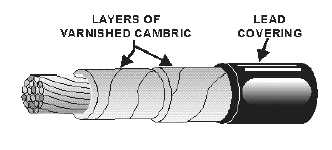1-16
Plastics
Plastic is one of the more commonly used types of insulating material for electrical conductors. It has
good insulating, flexibility, and moisture-resistant qualities. Although there are many types of plastic
insulating materials, thermoplastic is one of the most common. With the use of thermoplastic, the
conductor temperature can be higher than with some other types of insulating materials without damage
to the insulating quality of the material. Plastic insulation is normally used for low- or medium-range
voltage.
The designators used with thermoplastics are much like those used with rubber insulators. The
following letters are used when dealing with NEC type designators for thermoplastics:
Letter
Designates
T
Thermoplastic
H
Heat-resistant
W
Moisture-resistant
A
Asbestos
N
Outer nylon jacket
M
Oil-resistant
For example, a NEC designator of Type THWN would indicate thermoplastic heat- and moisture-
resistant with an outer nylon jacket.
Varnished Cambric
Varnished cambric insulation can withstand much higher temperatures than rubber insulation.
Varnished cambric is cotton cloth that has been coated with an insulating varnish. Figure 1-8 shows a
cable covered with varnished cambric insulation. The varnished cambric is in tape form and is wound
around the conductor in layers. An oily compound is applied between each layer of the tape to prevent
water from seeping through the insulation. It also acts as a lubricant between the layers of tape, so they
will slide over each other when the cable is bent.
Figure 1-8.—Varnished cambric insulation.
Cambric insulation is used on extremely high-voltage conductors used in substations and
powerhouses. It is also used in other locations subjected to high temperatures. In addition, it is used on the
coils and leads of high-voltage generators. Transformer leads also use this insulation because it is
unaffected by oils or grease and has high dielectric strength. Varnished cambric and paper insulation for
cables are the two types of insulating materials most widely used at voltages above 15,000 volts. Such
cable is always lead covered to keep out moisture.

